MSI GF76 Katana laptop review: Decent performance for a good price

 Image: IDG / Dominic Bayley
Image: IDG / Dominic BayleyAt a glance
Expert’s Rating
Pros
Decent CPU performanceInteresting design with plenty of flairComfortable keyboard and trackpad
Cons
Lackluster GPU performanceThe display lacks brightnessAudio produces less-than-stellar bass
Our Verdict
While the MSI GF76 Katana’s powerful Intel 12th-gen CPU is up to the task, its RTX 3050 Ti GPU lacks performance in some newer games. Nevertheless, for gamers on a budget, this is a decent option.
Price When Reviewed
$1,250
Best Prices Today: MSI Katana GF76
RetailerPriceMicrocenter$769.96View Deal

The MSI Katana GF76 has decent CPU performance for a budget 17-inch gaming laptop thanks to its 12th-gen Intel Core i7 CPU. Plus, its Japan-inspired chassis exudes plenty of flair. However, the laptop’s 3050 Ti GPU performance may underwhelm some gamers. On the one hand, it lets you enjoy games with cinematic ray-tracing graphics at an affordable price, but on the flipside it’s quite underpowered, even when performance sliders are pushed all the way to the right in MSI Center.
That being the case, recommending this laptop is horses for courses. If you don’t mind modest performance in some newer games, the MSI GF76 is a decent option. On the other hand, if nothing less than super quick framerates will do, you might want to consider one of the step-up models with RTX 3060 or RTX 3070 GPUs.
MSI GF76 Specifications
You can find seven configurations of the GF76 Katana listed on the MSI website. All feature 12th-generation Intel Core i7-12700H CPUs, but different RTX 30 series GPUs or storage capacities. Only four were available at the time of writing this review: two configurations with RTX 3050 Ti starting at $1,250 (currently $1,099) and two with RTX 3060 starting at $1,399. A configuration with RTX 3070 and another with RTX 3070 Ti have been marked ‘coming soon,’ as has a third configuration with RTX 3060. Pricing is yet to be revealed for these units. The specification for our review unit is as follows:
CPU: Core i7-12700HRAM: 16GB DDR4/3200MHzGPU: Nvidia GeForce RTX 3050TiDisplay: 17.3-inch FHD (1920 x 1080), non-touch, IPS-Level panel, 144Hz refresh rate, 45 percent NTSCStorage: 512GB PCle 4 SSDPorts: 1 x USB Type-C 3.2 Gen1, 2 x USB Type-A 3.2 Gen1, USB Type-A 2.0, HDMI 2.0 (4K @ 60Hz), 3.5mm Combo jack, RJ45 Gigabit EthernetNetworking: Wi-Fi 6 (802.11ax 2×2), Bluetooth 5.2Dimensions: 15.67 x 10.75 x 0.99 inchesWeight: 5.73 lbs (2.25kg); the power brick weighs 0.9 lbs (400g)Operating system: Windows 11 HomeColor: BlackBattery capacity: 53Whr
Design and build
Those familiar with the 2021 GF76 Katana will notice that the design hasn’t changed much in the 2022 edition. The GF76 Katana still has a hint of samurai about it, like an instrument of war or well-made suit of armor from medieval Japan. It sports a distinctive all-black chassis, red illuminated keys, and raised curved edges. We’re told this design is the brainchild of Japanese illustrator Tsuyoshi Nagano, who has gained some notoriety for his work as the original cover artist for the Romance of the Three Kingdoms games.

MSI
MSI
MSI
Design pedigree aside, the samurai katana theme makes it a real looker and one I was happy to play on at any opportunity. The laptop’s most prominent feature is a solid spine with curved edges, located at the base of the display which, from the back at least, resembles the blade of a katana. This feature makes it quite easy to carry. The front of the base has convex curves that resemble a katana as well. These match corresponding curves on the top of the lid to fit snugly down like a clam shell. This compactness makes the laptop easy to clean.
Looking at the build quality, the 2022 GF76 Katana feels mostly plastic but not the kind of flimsy plastic you’ll see in some other budget gaming laptops. Make no mistake, this is a robust laptop with a solid feel around the keyboard and base where it’s likely to see the most battering in fast-paced games. Measuring 15.67 x 10.75 x 0.99 inches, it’s quite large, so you’ll need plenty of space to set it down.
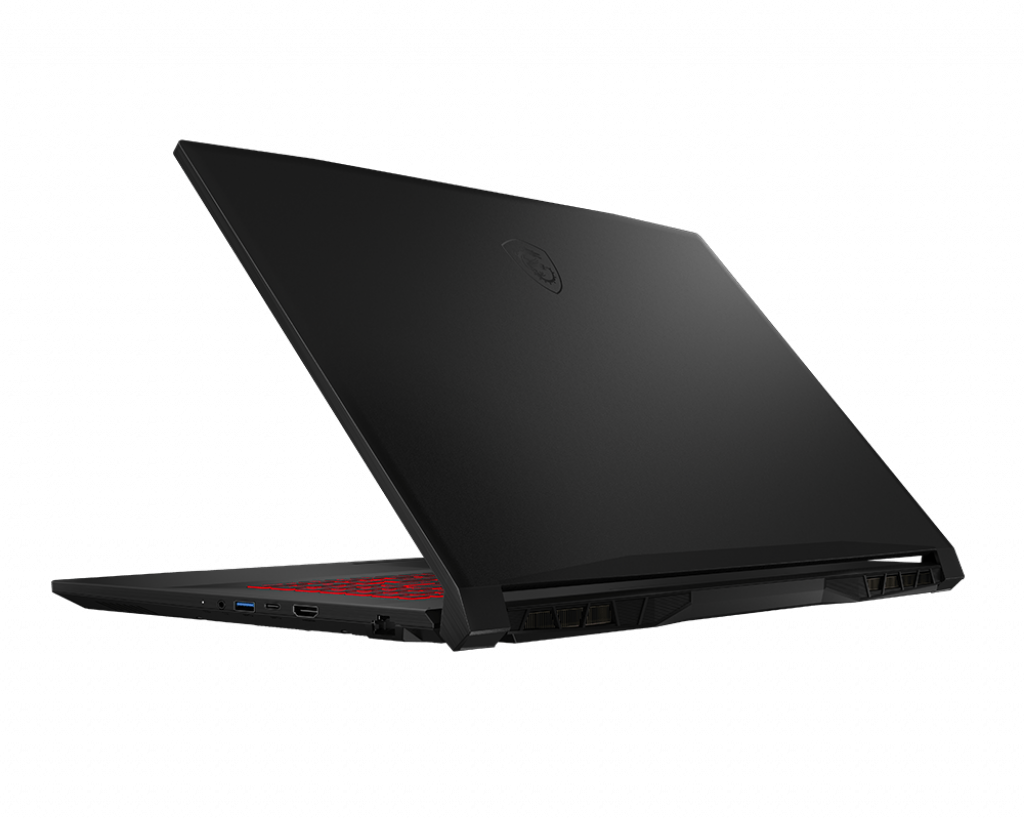
MSI
MSI
MSI
The hinges, which are metal, hold the display tightly in place at any position you might choose. However, the top’s slenderness means you’ll still see some flex if you apply pressure. It also wobbles a bit if you bump it, but it won’t bounce in a light breeze, which makes the GF76 suitable for gaming al fresco.
All the plastic in the chassis means the GF76 is on the light side for a 17-inch gaming laptop. It weighs just 5.73 lbs. In comparison to rivals, it’s lighter than the Asus Rog Zephyrus (6.06 lbs) and Gigabyte Aorus 17G (5.95 lbs), but heavier than the Dell XPS 9710 (5.34 lbs). This makes it a little more portable than some. Still, it’s heavy enough that you won’t want to carry it around everywhere you go.
Eyeballing the 16:9 display reveals very thin left and right bezels. The top bezel takes the shape of the aforementioned front lid, but doesn’t distract from your viewing experience.
Despite its distinctive curved edges, the GF76’s styling is understated. There are only two logos and they’re both quite small – an elegant black-on-black MSI Dragon appears on the top front of the lid like an engraving. The other, grey MSI lettering, sits on the lower bezel beneath the display. It replaces the black-on-black version in the 2021 edition, which looked a bit like an erased word.
While most laptops feature utilitarian undersides, MSI has made a style statement there. Flipping the unit over reveals an array of honeycomb-shaped air vents that, judging by the lack of heat we noticed while playing, are as practical as they are stylish.
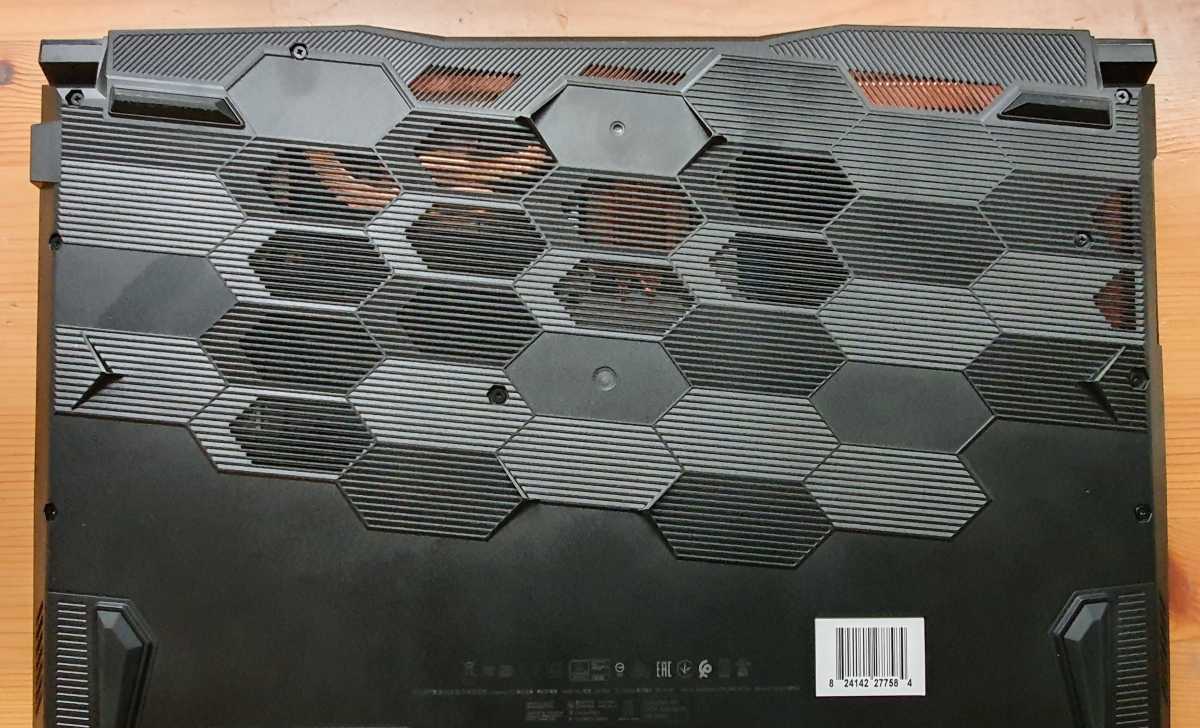
IDG / Dominic Bayley
IDG / Dominic Bayley
IDG / Dominic Bayley
Four large rubber feet located at the front and back give it plenty of lift off a tabletop, so you can rest assured its fan blades are ventilated.
Keyboard and touchpad
The keyboard and trackpad left a positive impression on me, despite needing a bit of time to adjust to them. For typing on, the keys didn’t feel too mushy or sluggish, with enough key travel to respond quickly when I hit them. The trackpad also worked well. It registered clicks immediately and looked pretty responsive to my finger movements.
MSI has kept the keyboard and trackpad positioning roughly the same as last year. However, one noticeable change is that some keys that previously had just symbols on them now have text on them. This looks better and should make them easier to locate.
Some might bemoan a single red color for the backlighting, but I found it gave the keyboard a fierce appearance that looked impressive when the lights went out. You could even say it helps rev you up a little, subtly encouraging you to stay fierce in your game.

IDG / Dominic Bayley
IDG / Dominic Bayley
IDG / Dominic Bayley
MSI has ensured you can toggle through three brightness levels or turn backlighting off completely if you want to save power. Doing this removes the illumination, but for better or worse, the keys still look quite red with the backlighting off.
An occasional hang up with typing is the keyboard font, which is quite different to what we’re accustomed to. It threw me off for a while, even though I’m a confident touch typist. It confuses you for just a split second when you peek down at your hands and find yourself thinking… Did I just hit a G or an O? It can be a little distracting at times, as some keys just look too similar.
Display and audio
The MSI GF76’s 17-inch FHD display provides you with plenty of visual real-estate to really get immersed in your games. It also has a key element that I look for in a gaming laptop – a decent refresh rate. In this case, it’s 144Hz.
For the most part, the fast display kept games and video looking quite smooth without any observable micro stuttering. There was just the mildest hint of ghosting visible when the pixel rate struggled to keep up with fast moving images.
Looking at the color and contrast, it’s perfectly fine for a budget laptop. You won’t see the kind of color depth you might find in a more premium panel and some images appear a little washed out, especially if you’re accustomed to 4K. But the display does only have a 45 percent NTSC color gamut. For a sub-$1300 laptop, this is perfectly reasonable coverage. If you’re not doing photography or design work, you’ll barely notice.
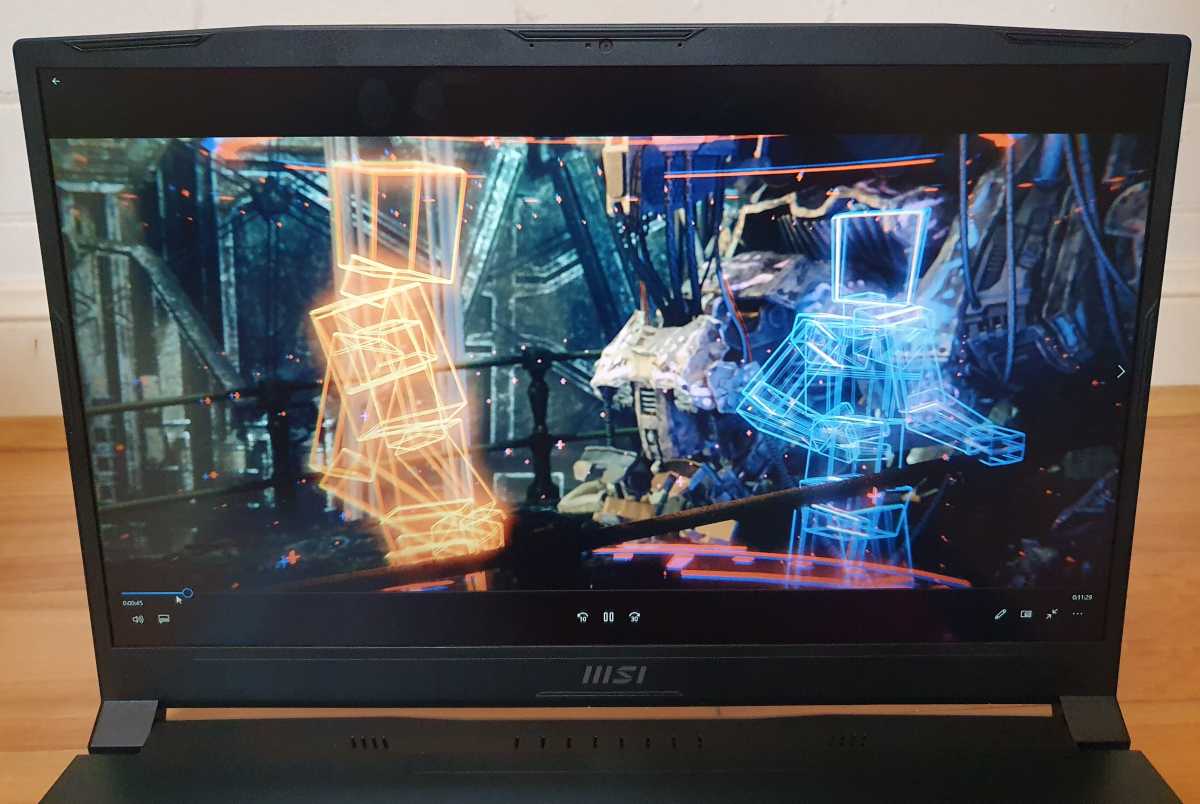
IDG / Dominic Bayley
IDG / Dominic Bayley
IDG / Dominic Bayley
The biggest drawback is the display’s brightness. We measured 270 nits peak brightness, which isn’t great these days even for a cheaper unit. It’s enough for decent viewing indoors, but you’ll probably want to avoid playing outdoors in sunlight.
In regards to the GF76’s audio, the two 2 watt speakers are located beneath the front left and right of the laptop’s base. Despite being on the underside, they produce sound with surprisingly good mid and high range tonal fidelity. That said, the bass range is lacklustre, particularly for a laptop of this size.
Connectivity
The GF76 provides you with a good complement of ports, including both USB Type-A and Type-C ports. A HDMI 2.0 port allows you to hook up an extra display or TV and stream 4K images at up to 60 frames-per-second. It also has an ethernet port for gamers that want the fastest network speeds.

IDG / Dominic Bayley
IDG / Dominic Bayley
IDG / Dominic Bayley
Unfortunately, the MSI GF76 Katana isn’t equipped with a Thunderbolt 4 port, which is a useful feature that lets you transfer hefty game files at data speeds of up to 40Gbps. Despite this, the laptop does support the latest Bluetooth 5.2 and Wi-Fi 6 technology for fast connectivity unplugged.

IDG / Dominic Bayley
IDG / Dominic Bayley
IDG / Dominic Bayley
Performance
The GF76’s Katana’s performance really is a double-edged sword (pardon the pun). It packs plenty of CPU power thanks to its 12th-gen Intel Core i7-12700H CPU, which proved too quick for older chipsets in our test group. However, its RTX 3050 Ti GPU showed lackluster performance at times, especially in newer 3D games. It stood in stark contrast to the laptop’s CPU performance.
We pitted the $1,250 GF76 Katana against a selection of gaming laptops from a line-up of recent PCWorld reviews. These laptops vary in size and hardware configurations, but most have older CPUs and all of them have more powerful RTX 30 Series GPUs. That list included other 17-inch gaming laptops like the Gigabyte Aorus 17G, the Dell XPS 17, and the Asus ROG Zephyrus S17. The line-up also included the 16-inch HP Victus 16 with a Core i7-11800H CPU. Although this last laptop is smaller in size, its starter configuration sits within the same budget gaming category as our review unit.
First up, we ran Maxon’s Cinebench R20 benchmarks. The single-threaded benchmark provides us with a metric of real-world processor performance and the multi-threaded score indicates how fast the CPU handles multi-processing tasks like rendering and encoding.
As you can see in the graph for our single-threaded test below, the GF76 Katana ranked the highest among our competitor laptops, proving too good for even the premium Asus ROG Zephyrus S17 with its sporty 11th-gen Core I9 processor.
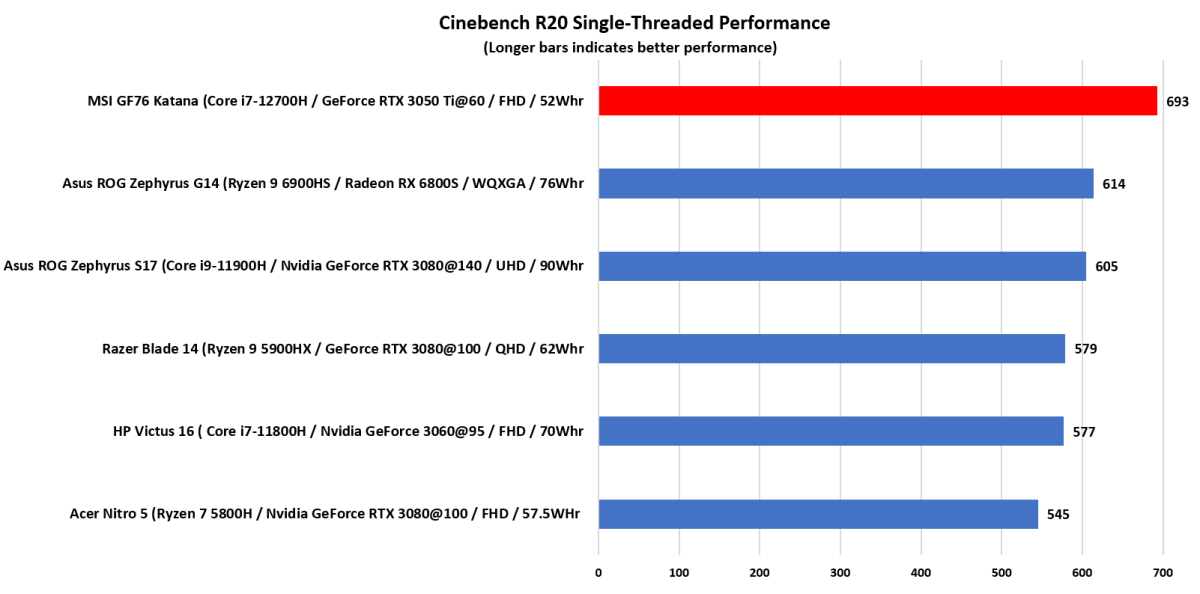
IDG / Dominic Bayley
IDG / Dominic Bayley
IDG / Dominic Bayley
Similarly impressive performance was recorded when all 14 Cores of our GF76’s i7-12700H chipset were put to the test, proving that this laptop is suitably powerful for a range of CPU intensive tasks like 3D gaming and encoding.
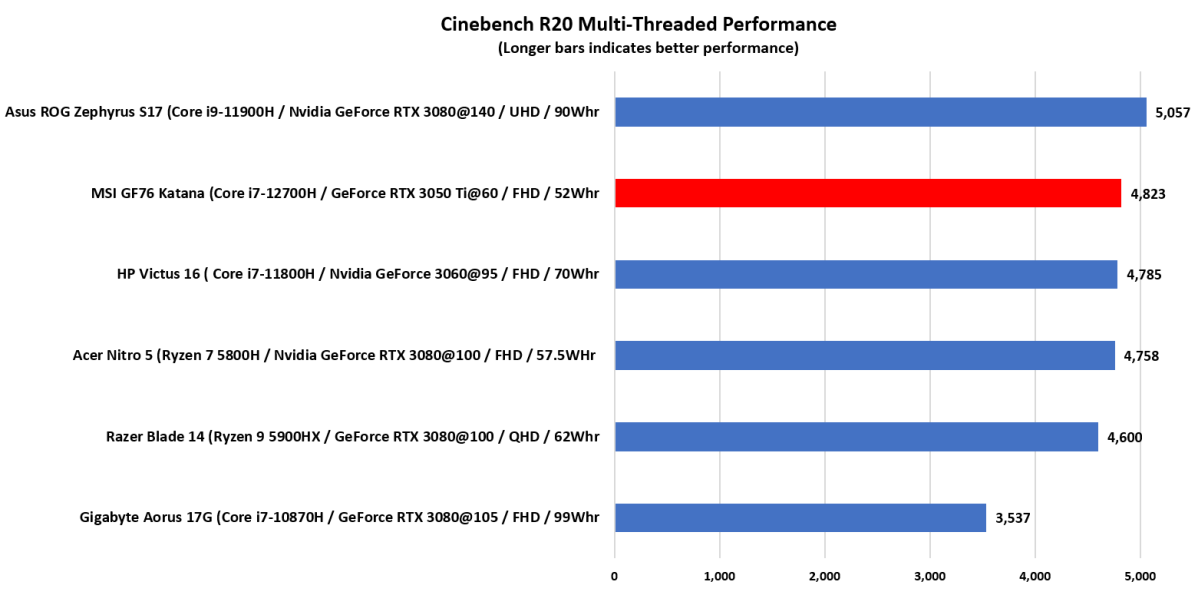
IDG / Dominic Bayley
IDG / Dominic Bayley
IDG / Dominic Bayley
Our next test utilizes the free HandBrake 0.9.9 utility software to encode a 30GB 1080p MKV file to MP4 using the Android Tablet Preset. Once again, the MSI GF76 Katana proved a capable performer, finishing the task faster than two of its 17-inch rivals. This result shows us that the GF76 has the legs to keep working under heavy CPU load before it gets too hot and needs to throttle performance.
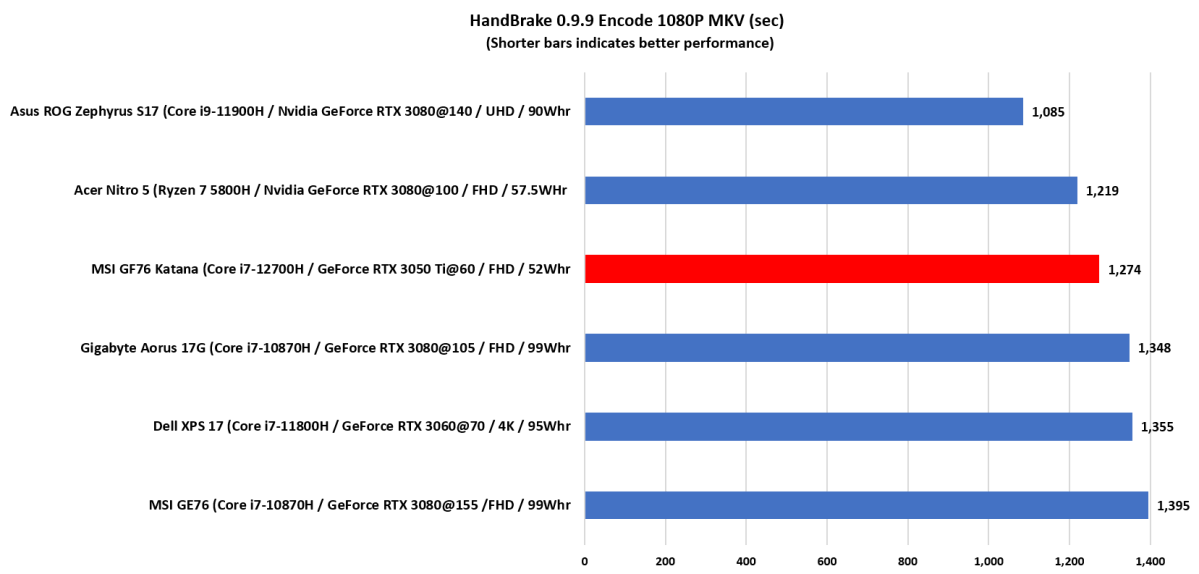
IDG / Dominic Bayley
IDG / Dominic Bayley
IDG / Dominic Bayley
Both CPU test results also demonstrated the superiority of Intel’s new 12th-gen CPU chipsets over some of the older Intel and AMD chipsets. These feature both Performance and Efficiency Cores that Intel Thread Director splits tasks between to optimize performance. In the case of our GF76’s Core i7-12700H, it has 6 Performance cores and 8 Efficiency Cores, giving it a performance edge over some of the older Intel CPUs with just Performance Cores.
Gaming performance
When it came to gaming performance, the GF76 Katana performed consistently well in older 3D games but its RTX 3050 Ti GPU set to 60W Total Graphics Power (TGP) underperformed in newer AAA games that rely heavily on the laptop’s GPU. This scenario played out in our gaming benchmark results below.
To get a general idea of 3D gaming performance, we ran the 3DMark Time Spy 1.2 benchmark. Our review unit’s score was quite a bit off the pace set by rival laptops with more powerful GPUs – including the MSI GE76 Raider equipped with 12th-gen i9 CPU and RTX 3080 Ti GPU, which isn’t a budget laptop but we added just for comparison (in green).
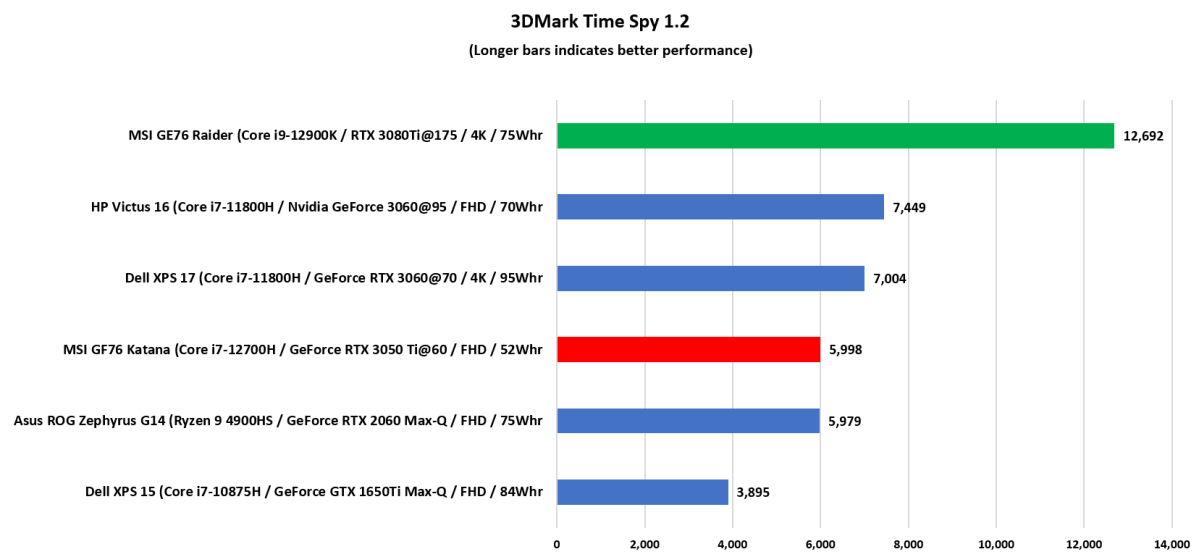
IDG / Dominic Bayley
IDG / Dominic Bayley
IDG / Dominic Bayley
In our (circa 2015) Rise of the Tomb raider benchmark, the MSI GF76 showed respectable performance, beating even the Razer Blade 14 with Ryzen 9 5900HX CPU and GeForce RTX 3080 set at 100W TGP.

IDG / Dominic Bayley
IDG / Dominic Bayley
IDG / Dominic Bayley
The story was very different when we ran the newer and more GPU dependent Metro Exodus benchmark. Our review unit came in behind the rest of the field.
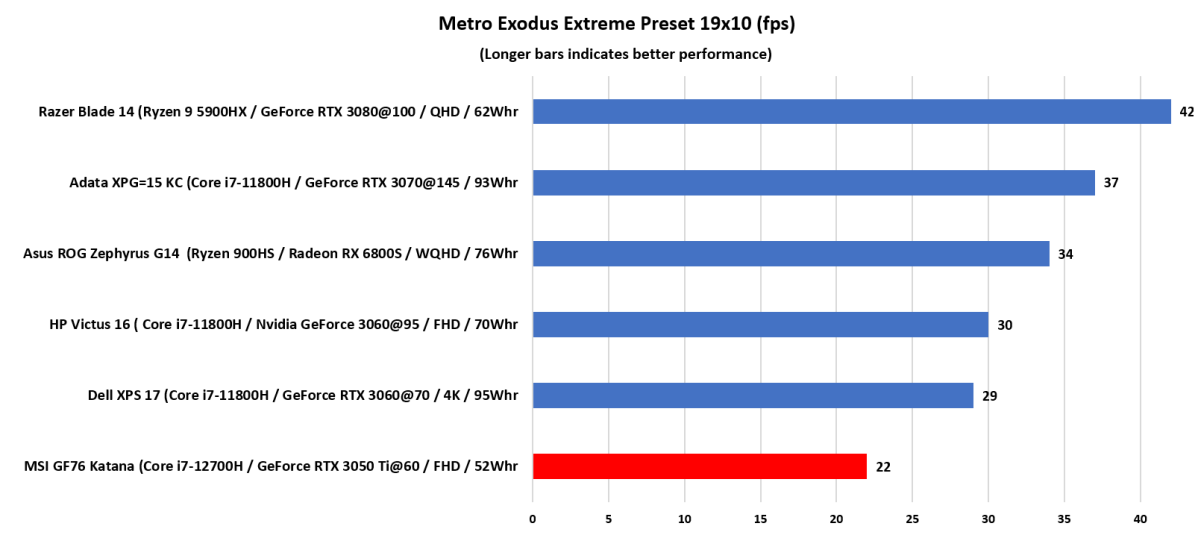
IDG / Dominic Bayley
IDG / Dominic Bayley
IDG / Dominic Bayley
Switching to Performance Mode in the MSI Center and turning on the CoolerBoost fan setting raised the Katana’s fps in both of these benchmarks. During the Rise of the Tomb Raider benchmark, it jumped to a respectable 96. Running the Metro Exodus benchmark produced a result of 24 fps. However, referring back to the Metro Exodus chart, this score wouldn’t have changed the positioning of the MSI GF76 Katana among our comparisons.
So, what does this last result mean? It means we need to take some perspective on the hardware capabilities of this laptop’s GPU. The MSI GF76 is a budget gaming laptop and the RTX 3050 Ti is positioned second from the bottom in the RTX 30 Series line-up chart and with less power than the GPUs in our test group. This makes a big difference in GPU-skewed games.
The RTX 3080 has 6144 Nvidia CUDA cores, 192 Tensor Cores, and 48 Ray Tracing Cores. The RTX 3050 TI has only 2560 CUDA Cores, 80 Tensor Cores, and 20 Ray Tracing Cores. If you want better performance and have a larger budget, you could always opt for an MSI GF76 with an RTX 3060 or 3070 GPU.
Our review unit is still a respectable option, though. Nvidia estimates its GeForce RTX 3050 Ti is 40 percent faster than the older GeForce GTX 1650 Ti and 20 percent faster than the RTX 3050, which is nothing to sneeze at.
Battery life
The MSI GF76 Katana comes with only a three cell 53Whr battery, which seems a little small for a laptop of this size. However, it did manage to last more than 5 hours in our lightweight battery test. Our benchmark ran the battery down from 100 percent to standby by playing a 4K video on repeat. This result suggests you could expect approximately 3 hours battery life for an unplugged gaming session, which is about on par with other similar laptops.

IDG / Dominic Bayley
IDG / Dominic Bayley
IDG / Dominic Bayley
Conclusion
The MSI GF76 Katana is a budget 17-inch gaming laptop with decent CPU performance. The RTX 3050 Ti GPU is a little underpowered for the latest AAA games, but you can still enjoy RTX graphics at a fraction of the cost of a more premium laptop. Although we expected better gaming performance, this laptop is still worth considering, especially if you’re on an inflexible budget.
Best Prices Today: MSI Katana GF76
RetailerPriceMicrocenter$769.96View Deal

Author: Dominic Bayley, PCWorld Australia Editor
Based in Australia, Dominic Bayley is a hardcore tech enthusiast. His PCWorld focus is on PC gaming hardware: laptops, mice, headsets and keyboards.
Recent stories by Dominic Bayley:
Dell XPS vs. Inspiron vs. Latitude laptops: Which should you buy?Asus ROG Zephyrus G14 review: Small, thin, and impossibly mightyRazer Blade 14 review: Still Razer’s most versatile gaming laptop



